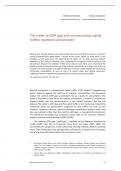Exam (elaborations)
The credit-to-GDP gap and countercyclical capital buffers: questions and answers
- Course
- Institution
Evaluating EWIs with the AUC The AUC (the area under the receiver operating characteristics curve, or ROC curve) is a statistical tool used in assessing the performance of signals that forecast binary events (ie events that either occur or do not). The term ROC reflects the origins of the too...
[Show more]



